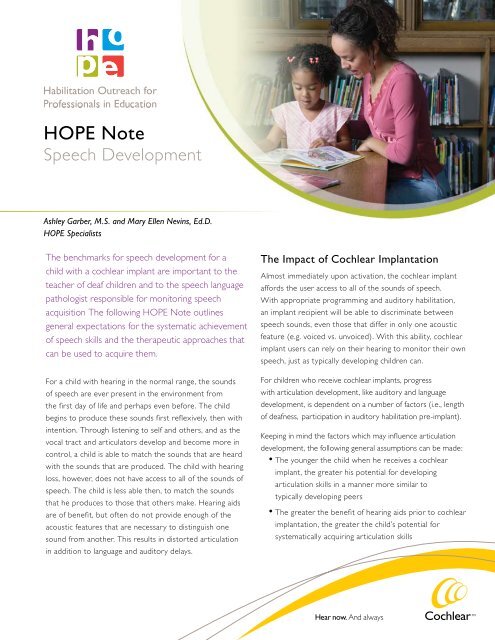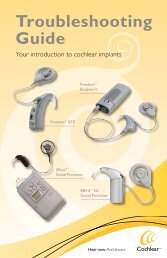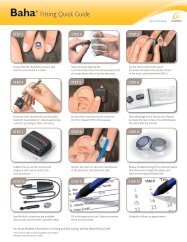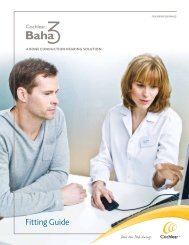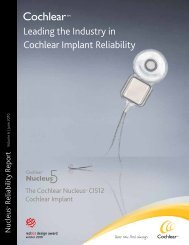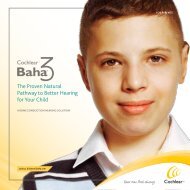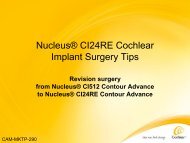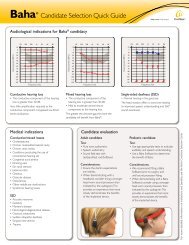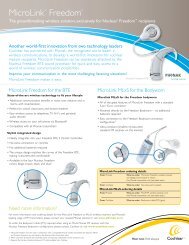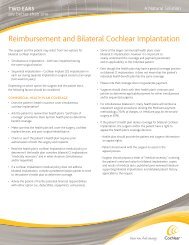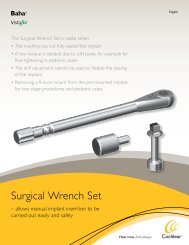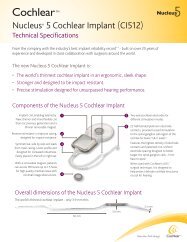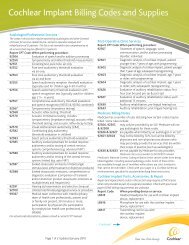HOPE Note - For professionals - Cochlear Americas
HOPE Note - For professionals - Cochlear Americas
HOPE Note - For professionals - Cochlear Americas
Create successful ePaper yourself
Turn your PDF publications into a flip-book with our unique Google optimized e-Paper software.
<strong>HOPE</strong> <strong>Note</strong><br />
Speech Development<br />
Ashley Garber, M.S. and Mary Ellen Nevins, Ed.D.<br />
<strong>HOPE</strong> Specialists<br />
The benchmarks for speech development for a<br />
child with a cochlear implant are important to the<br />
teacher of deaf children and to the speech language<br />
pathologist responsible for monitoring speech<br />
acquisition The following <strong>HOPE</strong> <strong>Note</strong> outlines<br />
general expectations for the systematic achievement<br />
of speech skills and the therapeutic approaches that<br />
can be used to acquire them.<br />
<strong>For</strong> a child with hearing in the normal range, the sounds<br />
of speech are ever present in the environment from<br />
the first day of life and perhaps even before. The child<br />
begins to produce these sounds first reflexively, then with<br />
intention. Through listening to self and others, and as the<br />
vocal tract and articulators develop and become more in<br />
control, a child is able to match the sounds that are heard<br />
with the sounds that are produced. The child with hearing<br />
loss, however, does not have access to all of the sounds of<br />
speech. The child is less able then, to match the sounds<br />
that he produces to those that others make. Hearing aids<br />
are of benefit, but often do not provide enough of the<br />
acoustic features that are necessary to distinguish one<br />
sound from another. This results in distorted articulation<br />
in addition to language and auditory delays.<br />
The Impact of <strong>Cochlear</strong> Implantation<br />
Almost immediately upon activation, the cochlear implant<br />
affords the user access to all of the sounds of speech.<br />
With appropriate programming and auditory habilitation,<br />
an implant recipient will be able to discriminate between<br />
speech sounds, even those that differ in only one acoustic<br />
feature (e.g. voiced vs. unvoiced). With this ability, cochlear<br />
implant users can rely on their hearing to monitor their own<br />
speech, just as typically developing children can.<br />
<strong>For</strong> children who receive cochlear implants, progress<br />
with articulation development, like auditory and language<br />
development, is dependent on a number of factors (i.e., length<br />
of deafness, participation in auditory habilitation pre-implant).<br />
Keeping in mind the factors which may influence articulation<br />
development, the following general assumptions can be made:<br />
• The younger the child when he receives a cochlear<br />
implant, the greater his potential for developing<br />
articulation skills in a manner more similar to<br />
typically developing peers<br />
• The greater the benefit of hearing aids prior to cochlear<br />
implantation, the greater the child’s potential for<br />
systematically acquiring articulation skills
• Children may have additional speech disorders, in<br />
addition to their hearing loss, which may influence their<br />
progress in speech development.<br />
Following Typical Development<br />
When working with a young child with a cochlear implant,<br />
the early focus of speech intervention should be on auditory<br />
development with exposure to speech sounds in a sequence<br />
similar to typical speech acquisition (i.e. cooing and babbling,<br />
vocal play). This is followed by development of the following<br />
suprasegmental and segmental aspects of speech:<br />
• Duration, pitch and intensity<br />
• Vowels and diphthongs<br />
• Consonants (in the order of typical acquisition)<br />
° in single syllables with vowels<br />
° in repeated syllables with vowels<br />
° alternated with other consonants<br />
Remembering that children may require months of auditory<br />
input before output of sounds occur, this stage of acoustic<br />
input should not be rushed. Pairing the sounds of speech<br />
with objects and actions as in the use of Learning to Listen<br />
Sounds (Estabrooks, 1998) will assure that speech will<br />
develop in a meaningful way rather than as an isolated skill.<br />
<strong>For</strong> the older child with some prior level of speech<br />
development (perhaps one who has had limited benefit<br />
from hearing aids), the exposure to suprasegmentals and<br />
segmental features continues to be the suggested initial<br />
approach. However, remediation of speech sounds may be<br />
needed sooner and a more direct approach to articulation<br />
may need to be implemented. In conjunction with traditional<br />
approaches to articulation remediation, the following<br />
suggestions might be made to facilitate speech development<br />
using the newly available auditory input:<br />
• An auditory cue/model should always precede a tactile<br />
or visual correction<br />
• An auditory model should always follow a tactile or<br />
visual model<br />
• Children will benefit from evaluating their own productions<br />
relative to those of others (e.g. listening to the speaker’s<br />
model, and then listening to their own production to<br />
determine if the two were the same or different). This<br />
process is referred to as using the auditory feedback loop.<br />
FUN790 ISS1 JUL07<br />
Overall Speech Intelligibility<br />
<strong>For</strong> most children receiving a cochlear implant, mindful<br />
of their age at implantation and/or their prior auditory<br />
experience, the cochlear implant offers improved overall<br />
speech intelligibility as compared to deaf children using<br />
traditional hearing aid technology. Improvements in<br />
nasality, relief of vocal strain and greater control of volume<br />
are frequent benefits for users with extended periods<br />
of deafness once access to all of the sounds of speech is<br />
achieved. Enhanced auditory feedback allows cochlear<br />
implant users to better monitor the suprasegmental<br />
qualities of their own speech This, in turn, contributes to<br />
improved rate of speech as well as more precise word and<br />
sentence boundaries. Additionally, once cochlear implant<br />
users develop segmental discrimination skills they are able<br />
to make use of their auditory feedback loop to compare<br />
their speech productions with those of others. This leads to<br />
closer approximations of target phonemes. Thus, as a result<br />
of the auditory benefits of speech perception afforded by<br />
the cochlear implant, children who receive their implants<br />
at an early age have the potential to develop speech that<br />
parallels that of their hearing age mates.<br />
Related Resources<br />
Caleffe-Schenck, Nancy (2007). Sound Speech for Speech Sounds.<br />
<strong>HOPE</strong> Online Library. Available at www.cochlear.com/<strong>HOPE</strong>.<br />
Chute, P. & Nevins, M.E. (2006). Clear Speech: The Possible<br />
Dream, in School Professionals Working with Children with<br />
<strong>Cochlear</strong> Implants, San Diego: Plural Publishing.<br />
Estabrooks, Warren (1998). <strong>Cochlear</strong> Implants for Kids. Alexander<br />
Graham Bell Association for the Deaf, Washington, D.C.<br />
Estabrooks, Warren (1998). <strong>Cochlear</strong> Implants for Kids.<br />
Washington, D.C.: AG Bell Publications.<br />
Ling, Daniel (1989) Foundations of Spoken Language for<br />
Hearing Impaired Infants. Alexander Graham Bell Association<br />
for the Deaf, Washington, D.C.<br />
Therres, MK. (2007) Learning to Listen: Starting to Speak.<br />
<strong>HOPE</strong> Online Library. Available at www.cochlear.com/<strong>HOPE</strong><br />
<strong>Cochlear</strong> <strong>Americas</strong><br />
400 Inverness Parkway<br />
Suite 400<br />
Englewood, CO 80112<br />
1 800 523 5798<br />
www.cochlear.com/<strong>HOPE</strong>


